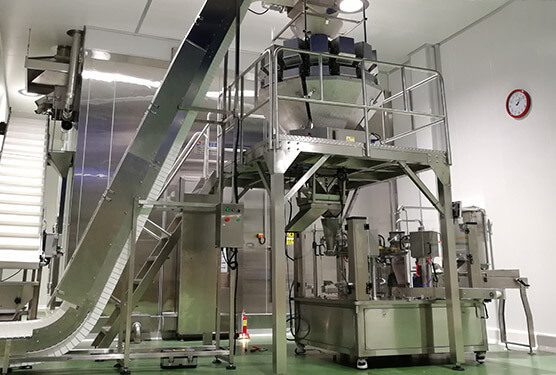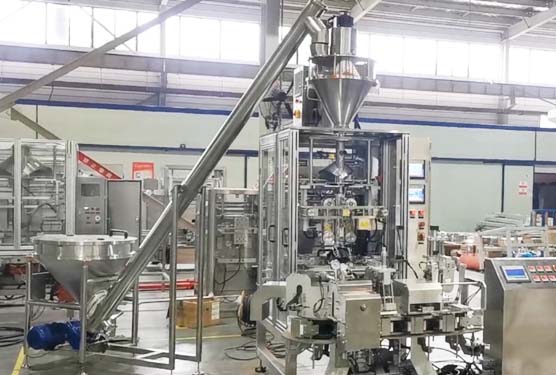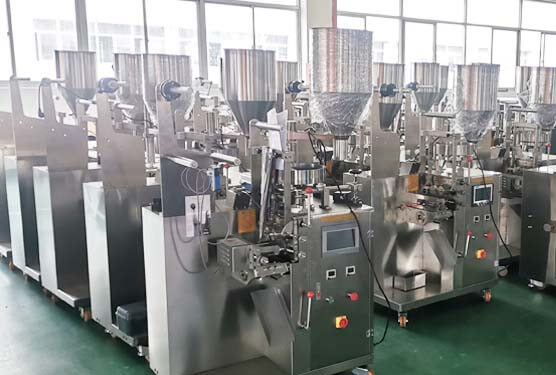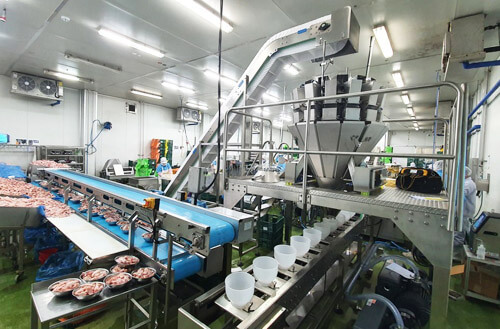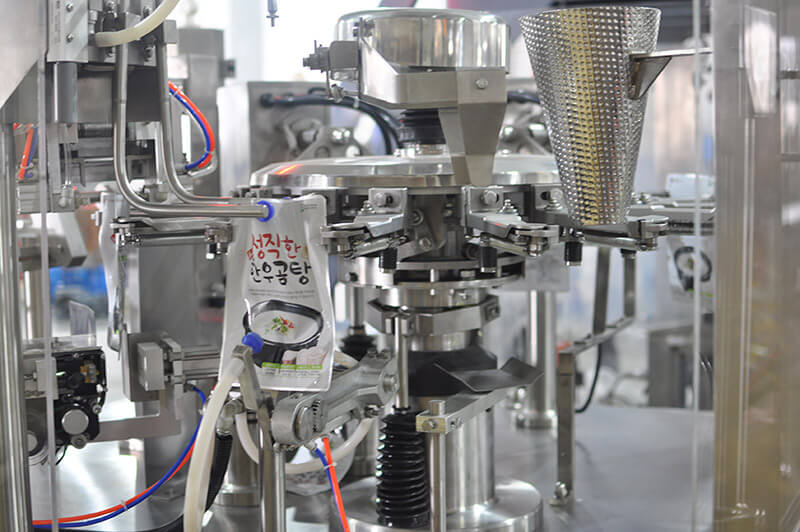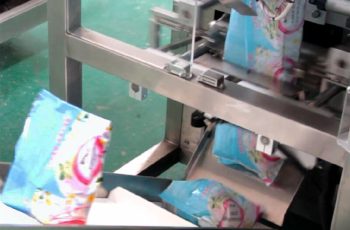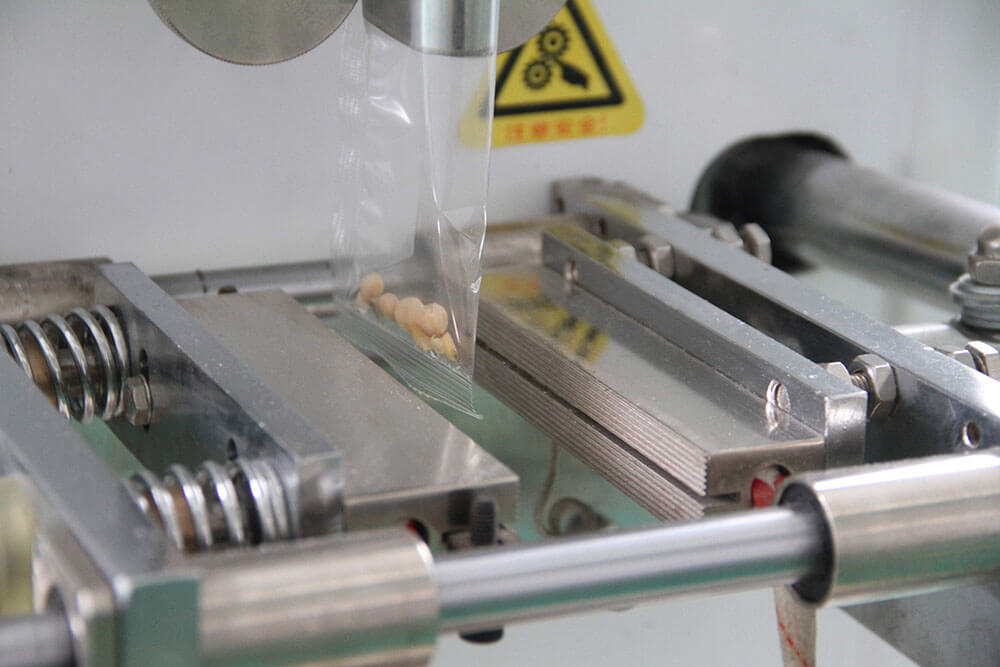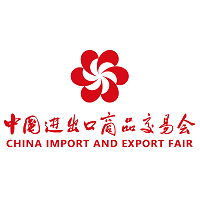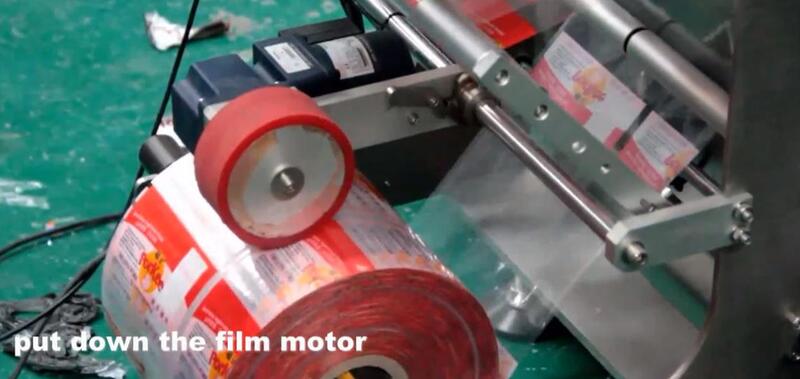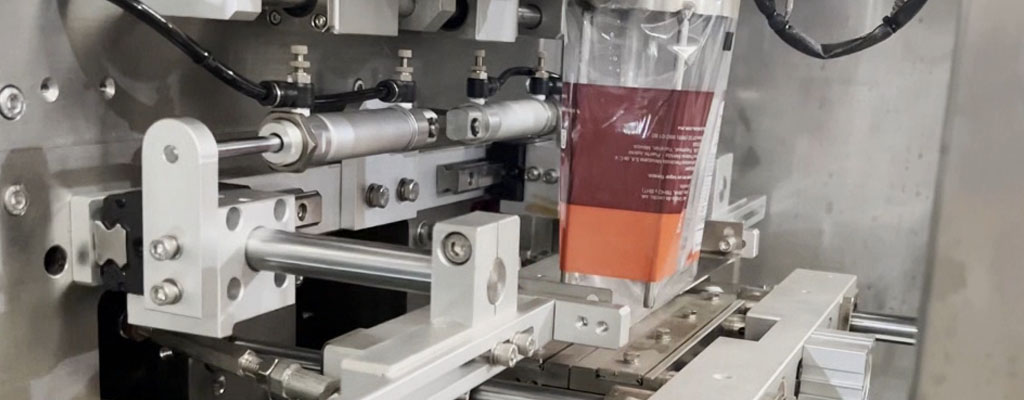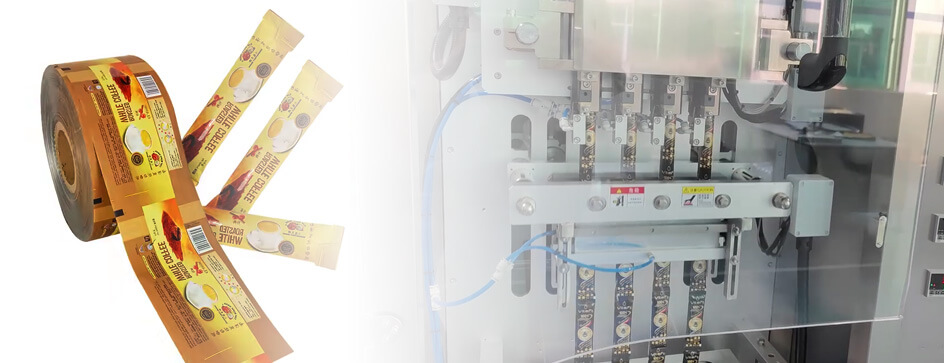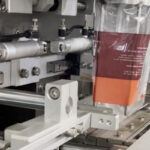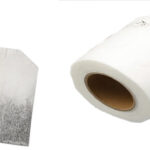Rollstock packaging is a popular packaging solution. Roll stock film is generally wrapped around a paperboard core. It is used in many industries, from food and pharmaceuticals to cosmetics. Using its laminated film to make pouches, sachets or bags.
What is Roll Stock Packaging
Roll stock is a long, continuous sheet of laminated film that is formed on a roll around a cylindrical paperboard core. It is converted into bags, pouches, or other packaging formats during the packaging process. It is widely used in various industries, including food, pharmaceuticals, and consumer goods. The roll stock is fed into packaging machinery that is unwound from a roll, then forms fills, and seals the material into the desired packaging shape, such as bags, pouches, or wrappers.
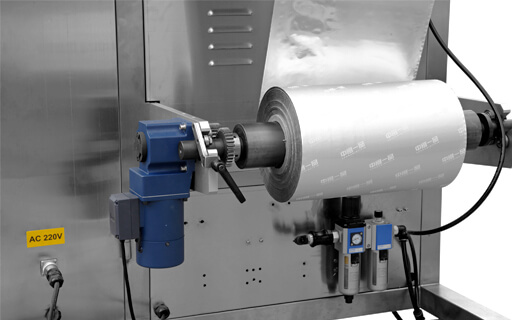
Bag Style Made of Roll Stock
Pillow Bags
Pillow bags are sealed at the top and bottom, with a seam running along the back. Widely used in snacks, chips, cereals, and other dry goods.
Stick Pouches
Stick pack pouches are long and narrow. They are popular for packaging tablets, vitamins and other powdered supplements.
Gusseted Bags
Bags with side gussets that expand when filled, providing more volume. Very suitable for heavy items. They are popular for packaging coffee, pet food, and large capacity items.
Stand-Up Pouches
Pouches with a bottom that allows them to stand up on shelves for better visibility and stability.
Widely used in sauces, snacks, and dried fruits.
Spout Pouches
Stand-up pouches with a spout for easy pouring and resealing. Often used in Liquids, sauces, dairy products, baby food, and beverages.
Vacuum Bags
Bags are designed to have the air removed to extend shelf life and maintain product freshness.
Widely used in meats, cheese, and other perishable items.
Quad Seal Bags
Quad seal bags are sealed on four corners, providing a strong structure.
Three-Side Seal Bags
Bags sealed on three sides with one side left open for filling, which is then sealed after filling. They can effectively prevent light and oxygen from entering.
Fin Seal Bags
Also can be referred to as T-Seal pouches, with a fin-like seal along the back that provides a stronger barrier. Often used in granola bars, cookies, and other snack items.
Flat Bottom Bags
Bags with a flat bottom and gussets on the sides.
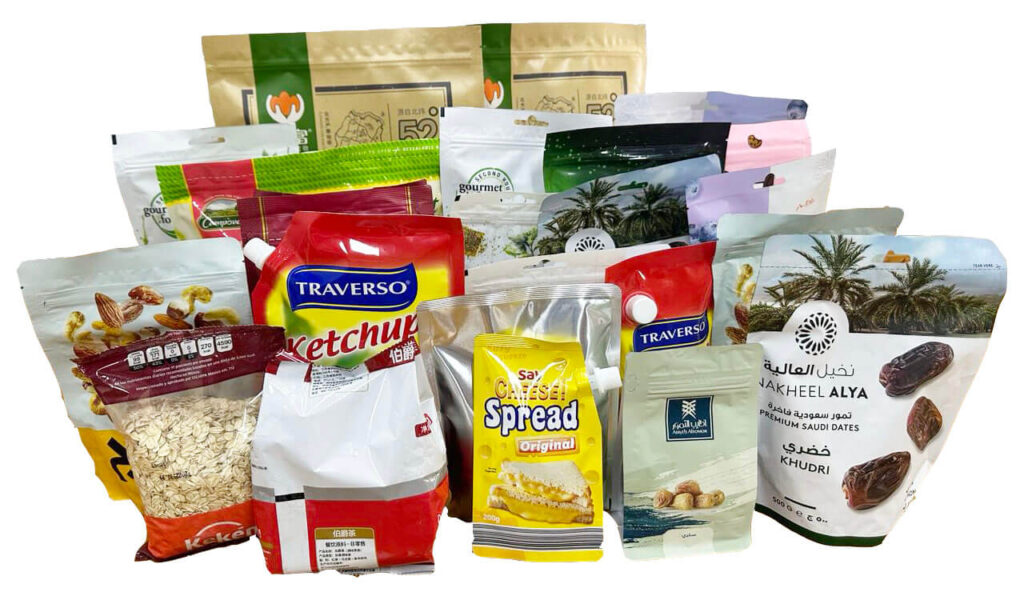
Benefits of Roll Stock Packaging
Efficiency
The manufacturing of rollstock packaging is continuous and offers high speed production. The films are flexible and continuous, reducing waste and lowering costs. Suitable for high-volume production. Furthermore, roll stock packages do not need labels. So it is quicker than other packaging methods.
Suitable for Aseptic Processing
The sterilization process of roller film is easier than that of preformed bags. Due to its unshaped nature, peroxide can quickly pass through the film thus covering the entire surface. It is also suitable for other sterilization methods such as high-temperature steam sterilization, ethylene oxide sterilization, plasma sterilization and electron beam sterilization. So they are preferred by the medical industry and the food industry.
Superior Graphic Reproduction
The ability of graphic reproduction is essential for shelf display and showing your brand. Roll stock can support high-resolution printing, allowing for detailed and sharp images. You can use rotogravure printing, digital printing or Flexographic printing. This is essential for displaying complex graphics, fine text, and high-quality photographs.
Customization
Roll stock packaging is customizable, you can choose sizes, materials, shapes, and printing designs.
It can be made from a variety of materials, such as plastic films, paper, and aluminum foil.
For environmental reasons, eco-friendly materials like recyclable, biodegradable, compostable, or recycled films can be used for roll stock packaging.
From small packages to large volume packaging, three-sided seal bag to four-sided seal bags. You can choose your ideal shape and size of your bags based on your needs.
High-quality graphic reproduction is supported by roll stock packaging. There are various printing techniques, like flexographic printing, gravure printing, and digital printing. You can use these techniques to print brand logos, complex designs, product information and barcodes.
Protection
Roll stock material has great protective properties in packaging, which are crucial for extending product shelf life, ensuring product quality and integrity. It protects the product from moisture and oxygen. And specialized roll stock materials like metalized films or aluminum foil have better light protection. They can block ultraviolet and other harmful light.
Roll stock material is strong and durable. It protects products from physical damage like compression, impact, and puncture during transportation and storage. Very suitable for fragile item packaging, electronic products packaging and shelf display.
In addition, it can effectively retain the aroma and flavor of the product, preventing loss or contamination by external odors. Widely used in coffee, tea, and spices.
Application of Roll Stock Packaging
The rollstock is durable, strong and has excellent barrier properties, keeping the bags’ integrity from damaging during transportation. It is popular in the food and cosmetics industries. And it has a great shelf display, very common in the use of daily necessities. Here are some examples.
| Industries | Product Examples | Packaging Feature |
| Food | bread, cake, frozen food like frozen vegetables, frozen fruits and frozen meats, candy, cookies, cheese sticks, dry goods like rice, flour, cereals, pasta, meat snacks, dried nuts, seeds | Durable, high-barrier properties to preserve freshness, customizable size. |
| Cosmetics and Personal Care Products | face masks, skincare creams, shampoos, toothpaste, hand sanitizers, wet wipes | Provides protection from contamination |
| Condiments | dry kibble, freeze-dried protein treats, powdered meal enhancers, horse feed | Easy to dispense, single-use |
| Pet Foods | dry kibble,freeze-dried protein treats, powdered meal enhancers, horse feed | Maintains product freshness, nutritional value, and strong sealing |
| Medical and Pharmaceutical Packaging | packaging for pharmaceuticals, vitamins, and health supplements, medical films, bags, or pouches | High-level protection from external elements, sterile packaging |
The Working Principles of Roll Stock Packaging Machine
Take the roll from the roll stock, put it around the roller of the machine. Unwinding the film through a series of guide rollers and tension control systems.
The material passes through forming devices. The machine uses compressed air, heat, or vacuum to thermoform the film into the desired shape.
The product moves into cavities. The product is accurately dispensed with different filling techniques according to the product type. Like gravity filling for solids, metering pumps for liquids, or vacuum filling for powders.
A set of heated horizontal sealing jaws come together. And heat and pressure are applied to create the seal. The cutting mechanism separates the sealed packages from the continuous film. This step creates the top and bottom seals of each package.
The completed packages are collected on an output conveyor, ready for further packaging and labeling.
Types of Roll Stock Lamination
Lamination packaging enhances the properties and performance of the packaging material, extending the shelf life of a product. It offers barrier protection, strength, and durability. Here is an analysis of the main types of roll stock lamination:
Solvent-Free Lamination
It uses solvent-free adhesives that cure through a chemical reaction at room temperature. It lowers the coat weight and is environmentally friendly. Suitable for frozen food, fresh goods or other items.
Metallized Lamination
Metallized lamination is Laminating metallized films (like aluminum foil or metallized plastic) with substrates. It has excellent barrier properties that can protect the product from moisture, light and oxygen. It also has great bonding properties.
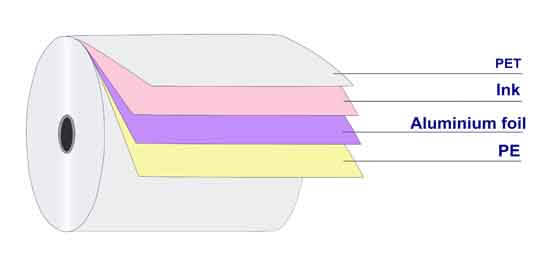
Surface Coating Lamination
It applies functional coatings (like anti-static or anti-fog coatings) to the substrate surface that adds specific functionalities to materials, and enhances packaging performance. It is popular in special-purpose packaging, such as electronic product packaging and special food packaging.
Thermal Lamination
Uses heat and pressure to bond different layers of materials like plastic and aluminum foil.
The process is simple, suitable for mass production and is stable. It is commonly used in food packaging, medical packaging, and industrial packaging.
High Barrier Rollstock Lamination
It has great durability and longer shelf life for perishable products. High barrier rollstock laminations protect product integrity and protect the product from light, moisture, and oxygen.
Water-Based Lamination
Uses water-based adhesives. It is eco-friendly and has no residual solvent. Suitable for food and pharmaceutical packaging.
Conclusion
Roll stock packaging’s superior performance is favored by many people and is used in many different industries. It is highly productive so it can be used for large-scale packaging production. It is also suitable for aseptic production and has good protective features, meeting the needs of industries such as medical and food. If you are interested and want to know more about roll stock packaging, please contact Honor Pack.

